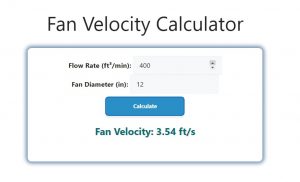About Fan Velocity Calculator (Formula)
In various industries, understanding airflow dynamics is crucial for ensuring optimal ventilation and efficiency. The Fan Velocity Calculator is a handy tool that helps engineers, HVAC technicians, and anyone involved in air movement calculations determine the speed at which air is moved by a fan. By analyzing factors like flow rate and fan diameter, this calculator provides essential insights into airflow performance, which is vital for designing effective ventilation systems. This article will discuss the formula used for the calculation, how to use the calculator, provide an illustrative example, and answer frequently asked questions related to fan velocity.
Formula
The formula for calculating fan velocity is:
Fan Velocity = Flow Rate / (π * (Fan Diameter / 2)^2)
Where:
- Flow Rate is the volume of air moved by the fan, typically measured in cubic feet per minute (CFM).
- Fan Diameter is the diameter of the fan, usually measured in inches.
How to Use
Using the Fan Velocity Calculator is straightforward and involves the following steps:
- Gather Data: Obtain the flow rate of the air in cubic feet per minute (CFM) and the diameter of the fan in inches. Ensure accurate measurements for reliable results.
- Input Values: Enter the flow rate and fan diameter into the calculator. If using a different unit for the diameter, convert it to inches.
- Perform the Calculation: The calculator will use the provided formula to compute the fan velocity.
- Interpret the Results: Analyze the result to understand the speed of air movement. This information is critical for assessing the effectiveness of ventilation systems and ensuring they meet desired airflow requirements.
Example
Let’s consider a practical example:
- Flow Rate: 400 CFM
- Fan Diameter: 12 inches
First, plug the values into the formula:
Fan Velocity = Flow Rate / (π * (Fan Diameter / 2)^2)
Calculating the area:
- Radius: Fan Diameter / 2 = 12 inches / 2 = 6 inches
- Area (A): π * (6 inches)^2 = π * 36 = 113.1 square inches
Now calculate the fan velocity:
Fan Velocity = 400 CFM / 113.1 square inches
Fan Velocity ≈ 3.53 feet per minute
In this example, the fan velocity is approximately 3.53 feet per minute, indicating the speed at which air is being moved through the fan.

FAQs
- What is fan velocity?
Fan velocity refers to the speed at which air is moved by a fan, usually measured in feet per minute (FPM). - Why is fan velocity important?
It helps determine the effectiveness of a ventilation system, ensuring adequate airflow for comfort and safety. - What units are used for flow rate?
Flow rate is typically measured in cubic feet per minute (CFM) or liters per second (L/s). - How do I measure fan diameter?
Measure the distance across the fan blade from one edge to the other, passing through the center. - Can I use this calculator for any fan type?
Yes, it can be used for any type of fan, as long as you have the flow rate and diameter. - What happens if I increase the fan diameter?
Increasing the fan diameter generally increases airflow and can lower the fan velocity for the same flow rate. - What if I have a variable flow rate?
You can calculate the fan velocity for different flow rates by repeating the calculations with each rate. - Is this calculator useful for HVAC systems?
Absolutely! It’s essential for HVAC design and analysis to ensure proper airflow throughout a building. - How does temperature affect fan velocity?
Higher temperatures can affect air density, impacting the flow rate and thus the velocity. - Can I use the formula for other applications?
Yes, it can be adapted for various applications involving airflow calculations in ducts and ventilation systems. - How accurate is the Fan Velocity Calculator?
The accuracy depends on the precision of the input values; ensure measurements are accurate for reliable results. - What is the impact of fan speed on velocity?
Increasing the fan speed typically increases the flow rate, which can lead to higher fan velocity. - Can I calculate fan velocity without knowing the flow rate?
No, the flow rate is a necessary input for determining fan velocity using this formula. - Are there any limitations to using this calculator?
It assumes steady-state airflow and does not account for factors like turbulence or obstructions. - How can I improve airflow in my system?
Consider adjusting fan size, increasing fan speed, or optimizing duct design for better airflow. - What is the relationship between fan velocity and static pressure?
Generally, higher fan velocities can create higher static pressures, affecting system performance. - Can this calculator be used in industrial applications?
Yes, it is applicable in various industries, including manufacturing and environmental control systems. - What is the best way to measure flow rate?
Use a flow meter or other appropriate measuring devices for accurate flow rate readings. - Can fan velocity affect energy consumption?
Yes, higher fan velocities may lead to increased energy consumption; optimizing velocity can enhance efficiency. - Where can I find more resources on fan performance?
Technical manuals, HVAC resources, and engineering websites offer extensive information on fan performance and calculations.
Conclusion
The Fan Velocity Calculator is an invaluable tool for anyone involved in designing or analyzing ventilation systems. By applying the formula Fan Velocity = Flow Rate / (π * (Fan Diameter / 2)^2), users can accurately determine the velocity at which air is moved by a fan. Understanding fan velocity is essential for optimizing airflow, enhancing energy efficiency, and ensuring the comfort and safety of spaces. Whether you’re a professional engineer, HVAC technician, or a DIY enthusiast, this calculator will aid you in making informed decisions about your airflow systems.